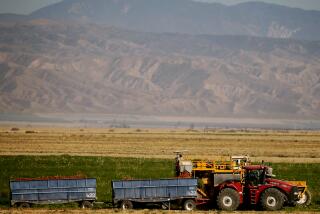Negotiate Now or Lose Later
- Share via
It seems the Los Angeles Department of Water and Power is doomed to pay forever for the sins that the city visited on the Owens Valley early this century by taking its water--stealing it, many critics still contend.
In the last decade, the department has been forced to give up roughly one-fifth of its Eastern Sierra water to repair environmental damage caused by the Los Angeles water diversion. Now the department is battling another loss under a proposed order of the Great Basin Unified Air Pollution Control District, the region’s air quality policing body.
The city began sending the Owens River through the L.A. Aqueduct in 1913, and the 110-square-mile Owens Lake began to dry up. Since the 1920s, the lake has been a virtual dust bowl.
When the winds whip down off the Sierra Nevada slopes, a massive dust cloud of salty particles chokes the southern end of the valley and beyond. The U.S. Environmental Protection Agency has declared the lake a major health hazard and directed state and regional officials to take corrective action by 2001.
The air district has proposed a $70-million mitigation project that includes flooding about 13 square miles of the lake bed with one to two inches of Owens River water--water that no longer would flow to Los Angeles. Water and Power’s reaction was all too typical of past battles in the Owens Valley: blustery defiance and threats of rate increases and legal challenges.
The department says the problem is overstated and that there is no evidence the air board’s plan would work. To replace the lost water would cost the city $23 million a year, officials claim, to be passed on to city residents in the form of rate increases approaching 10%.
The air board’s proposal may not be the best solution, but it should at least be considered a starting point. There definitely is a pollution problem. The board is under pressure from the EPA. While the mayor and some City Council members seem to understand that the city has responsibility to address this problem, DWP officials have dug in their heels. The prudent course for the DWP is not to send in its lawyers to fight to the last drop of water. The department has not been successful using such tactics.
The residents of both Los Angeles and the Owens Valley would best be served by continued negotiation and a reasonable settlement that does not include a rate increase to city water users.
More to Read
Sign up for Essential California
The most important California stories and recommendations in your inbox every morning.
You may occasionally receive promotional content from the Los Angeles Times.













